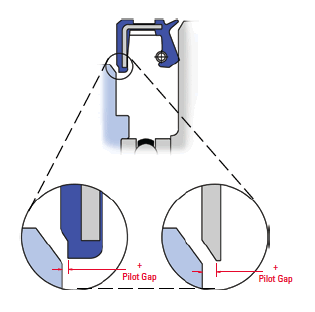
Radial shaft seals are pressed into a bore (Bore Types) to form a static seal. The static seal can be created by a metal-metal, rubber-metal, or a combination interference. The press-fitting action positions the seal both axially and radially. The head and heel section are properly aligned if the outside face of the case is perpendicular to the shaft axis. The affect of poor installation is seal cocking or damage to the outside diameter.
Cocking is caused by improper installation methods (Installation Methods). If there are such assembly space restrictions as a blind installation or no room to use the proper installation tool, alternative seal designs should be considered.
Failure to design a proper bore chamfer is the primary cause for damaging the seal O.D. The image illustrates the proper use of an installation chamfer, which allows for a positive pilot gap, positioning the seal against the chamfer prior to installation. When a proper tool is used, installation forces, cocking and spring back are all minimized. The result is longer seal life and less chance of leakage. If a sufficient chamfer is not possible, a customized seal O.D. should be designed. Contact ESP Engineering for design suggestions.